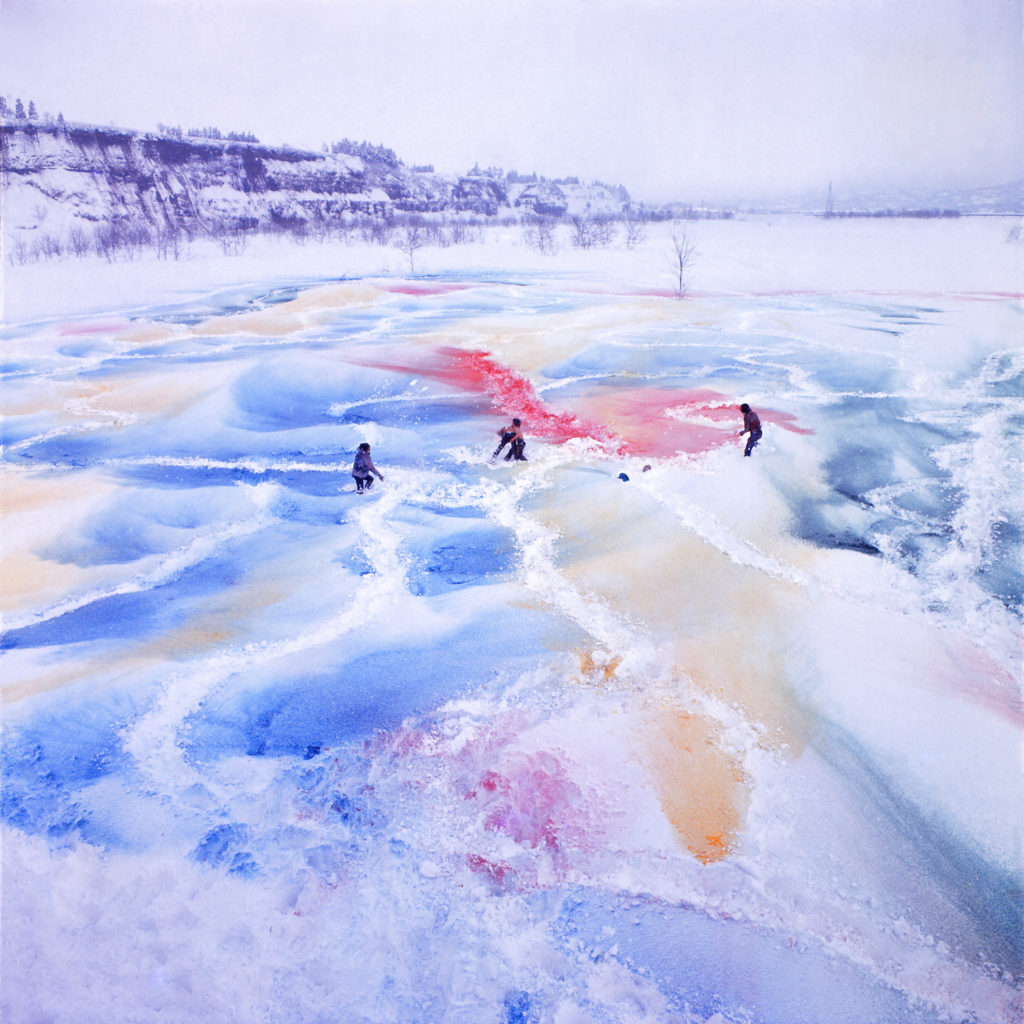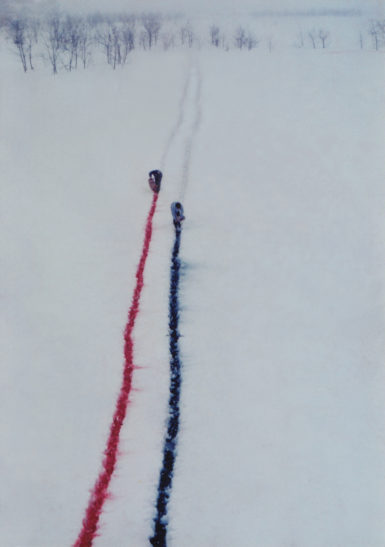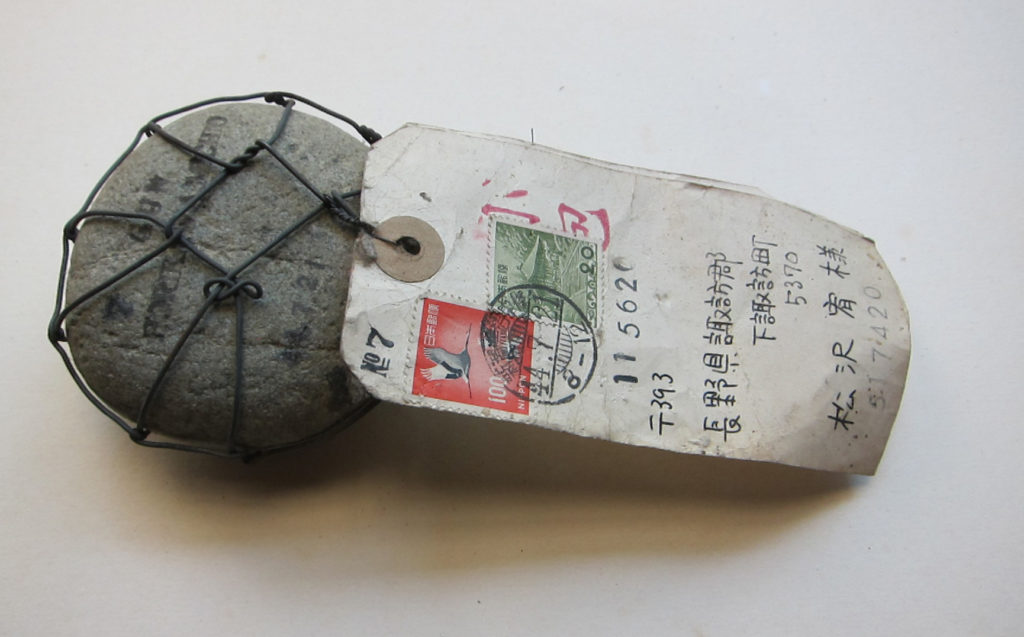[ad_1]

GUN, Event to Change the Image of Snow, 1970.
PHOTO ©HANAGA MITSUTOSHI AND ISO TOSHIKAZU/COURTESY GEIJUTSU SEIKATSU-SHA/PHOTO BY HORIKAWA MICHIO
Last week, the Japan Society in New York opened the exhibition “Radicalism in the Wilderness: Japanese Artists in the Global 1960s,” which focuses on artists in Japan during a time when international trends were beginning to have an impact on the country’s avant-garde. Featuring the artist Matsuzawa Yutaka and two art collectives, GUN and the Play, the exhibition demonstrates that artists in Japan were just as much at the forefront of Land art, mail art, and other conceptual strategies as their colleagues in the West.
Around the time of the show’s opening, ARTnews spoke with Horikawa Michio and Maeyama Tadashi, two of the founding members of GUN (short for Group Ultra Niigata). Now in their 70s, both artists recalled some of the collective’s more famous exploits, including mailing a rock to Richard Nixon as a Christmas gift and painting a snow-covered riverbed so that it appeared as a multicolored spectacle. “Radicalism in the Wilderness” curator Reiko Tomii acted as a translator and joined them to discuss GUN’s origins and attention-grabbing projects.
ARTnews: How does GUN fit into the 1960s Japanese art scene? What’s important about GUN?
Reiko Tomii: They came at the tail end of the 1960s, when the anti-art movement had died down and attention had shifted to non-art, Mono-ha, and “cool” conceptual art, rather than hot-tempered anti-art. The importance of GUN is that, usually, when you think about conceptual art movements of this period, you think about Tokyo. Members of GUN didn’t live in Tokyo. They stayed where they were born, in Niigata. It’s not that they didn’t have aspirations to connect with the artists in Tokyo, but ultimately they decided that locality was important, and this place could be an important inspiration for their art.
ARTnews: Did GUN have an impact on what was going on in Tokyo?
Tomii: Yes and no. Horikawa Michio was invited to the Tokyo Biennale in 1970, which was major, but that’s only because he made an effort to connect to Tokyo through mail art. This created a little bit of a critical stir, and then Event to Change the Image of Snow [1970], where GUN painted the snow-covered riverbed—that became major, not because art journalism picked it up, but because the general press covered it. The problem with GUN’s projects was that they were not things you could see. After they were complete, you could only know them through photographs, so it was all kind of ephemeral.
ARTnews: Michio and Tadashi, you met in high school. You were in the same art club, and you also attended college together. How did you decide to start GUN and collaborate on radical art projects?
Maeyama Tadashi: I had had a solo exhibition in Tokyo, and by the third year in college, I was making light art and Minimalist art. But my biggest influence was a critic named Ishiko Junzo from Shizoka, which is also outside of Tokyo. He challenged me to do something radical. As somebody living in Niigata, I thought of gathering people still living there.
Horikawa Michio: In school, I was looking at what was happening with various movements, such as Minimalism. Maeyama had a solo show in Tokyo, and he brought to Niigata many stories about people active in the international art world. It was all very different from what you read about in magazines.
In 1964, the city of Nagaoka opened Japan’s first-ever museum of contemporary art. It was only one hour away from where I lived, whereas getting to Tokyo took six hours. At the Nagaoka Contemporary Art Museum, you could see in person what you saw had only read about in magazines. Works of American and European art were there. For example, I saw Warhol’s 16 Jackies (1964) there. You could not even see this in Tokyo. It was from this important impetus that I thought contemporary art would be my passion. Then Mayeama-san talked to me, and we started working together. He was 23, and I was 21.
ARTnews: When you called yourselves GUN, did you think of the English word for gun?
Maeyama: When we talked about the group name, there were lots of ideas, but nothing measured up to our ambitions. GUN is an onomatopoeia—it sounds like a big gong. But then we had to discuss whether we’d use Japanese, Chinese, etc. Then we thought that in English it also means gun, but this didn’t come first.

Maeyama Tadashi, Event to Change the Image of Snow (Trajectory of Steps), 1970.
PHOTO ©HANAGA MITSUTOSHI AND ISO TOSHIKAZU/COURTESY GEIJUTSU SEIKATSU-SHA/PHOTO BY HORIKAWA MICHIO
ARTnews: When you first started GUN, you were mainly organizing exhibitions and bringing shows to Tokyo.
Maeyama: On the one hand, we wanted to break into Tokyo’s scene, and at the same time, we wanted to bring the energy of Tokyo back to Niigata. The cutting-edge art of the time was in Tokyo, but we got together in Niigata. So we did an exhibition in Niigata, and we also did Tokyo exhibitions. On the other hand, there was a certain resistance and animosity toward Tokyo as the center of the Japanese art scene.
ARTnews: When did you start doing mail art projects?
Horikawa: When I went to Tokyo, some people I met told me about mail art. In 1968, the critic Ishiko Junzo told me about Matsuzawsa’s mail art. At that time, I had just finished college, and I was still painting. I didn’t really start making mail art until a year and a half later. It was the least costly thing to do. Also, in 1969, On Kawara had an important exhibition of his mail art project in Tokyo. That was the first mail art that I saw.
Posting stones was my first attempt at mail art. It was very successful. I was striking out all the time up until then, and suddenly, with the mail art project, I hit a home run. I thought of mailing stones because Apollo 11 started its journey at that time, and I learned that its first mission was to collect the moon rocks. So I thought to collect stones on the same date that the Apollo 11 would be on the moon. I did the second project in this series in conjunction with Apollo 12, in November 1969. And then in December, another group, the Psychophysiology Research Institute, asked me to join them.
ARTnews: Why did you send a stone to Richard Nixon?
Horikawa: Nixon was the supreme commander of the Apollo missions. I thought it would be fun and interesting to send him stones.
ARTnews: Was it a protest?
Horikawa: The meaning of this protest emerged as I was doing this. The first time, in conjunction with Apollo 11, I wrote an essay about how we need to think about things on Earth, not just things in space. And when I decided to do the Nixon piece, I chose a black stone, so the color black carries the meaning of protest, too.
I sent the stone on December 7, 1969, and my very good friend, the photojournalist Hanaga Mitsutoshi, took a picture of it and turned it into a newspaper article. That newspaper article came out on January 8. In response, I was told that the U.S. embassy in Tokyo asked the White House if they received this or not. Then the State Department sent me a letter. I thought that America was a very humorous country, because you know what they wrote? “Thank you for the very thoughtful gift.” This would never happen in Japan, and indeed in May 1970, I sent a stone to Prime Minister Sato, and nothing happened. The important thing is the newspaper article was a part of a series, “Third Youth, new ideas and new movements,” and Japan had Expo 70 the next year. The country was really focused on new ideas and new developments. It was purely a coincidence that the photographer came to Niigata for some other things, but he took a picture and turned it into an article. I was lucky that he was there.
ARTnews: In 1970, GUN obtained permission from Niigata Prefecture’s Ministry of Construction to create their ephemeral and site-specific work Event to Change the Image of Snow, in which the group’s members sprayed an array of bright color pigments over the snow-covered dry riverbed of the Shinano River. GUN reprised the act four days later, and each event lasted only 30 minutes, as new snowfall quickly erased the huge color-field abstraction. How did the event in the snow come about?
Maeyama: I am very interested in actions and happenings—I did many in 1967 and 1968—so I wanted to do something that was a direct action, rather than one involving the making of an artwork. To be honest, at that time, GUN was in the pits. By 1967, we did five exhibitions in Niigata, but exhibitions cost a lot of money, especially if you invite people from Tokyo to come and have critics speak at the symposium. We didn’t get much critical attention. We really needed something to jumpstart our group, otherwise we would be over. Not only did we have to do something, we had to do something big. Niigata is buried under the snow for half of the year, and we wanted to transform the landscape completely, so that was the aesthetic idea.
Horikawa: There were lots of ideas, but [a work involving] snow was the one we all agreed on. The problem was how to realize the concept. One idea was to hire a helicopter and spread the pigments from the sky, so when people woke up in the morning the landscape would be totally yellow or red—a big surprise. But this was a pipe dream, budget-wise and scale-wise.
Not many people saw the work. Those people who passed on the big ridge, maybe they saw it, but they might have thought something strange was happening and forgotten about it. But thanks to the photographer [Mitsutoshi], a photo magazine put it on the cover, and inside there was an article about the piece. That was the achievement. It was not so much the action, but what we engineered. That photo even became the image on the back cover of a Japanese art book called Art Now. It was about happenings and actions and performance and they used our work as an illustration so that was the biggest reaction.

Horikawa Michio, The Shinano River Plan: 11, 1969.
COLLECTION OF MATSUZAWA KUMIKO
ARTnews: When did GUN disband?
Horikawa: GUN never formally disbanded, in a way. It just naturally faded out. Up until 1975, individual members did their own work under the name of GUN.
ARTnews: Are you still working today?
Maeyama: I am, and I intend to keep doing so.
Horikawa: If we stop now, it is all over. We want to keep up the memory of what we did together. We may have some ups and downs, and we are more than 70 years, but yes, we’ll continue. Maybe every five years, I’ll get a good idea.
Maeyama: For me, the most attractive thing about art is that you don’t do what other people do. You can make your own things. That may be the only freedom we have in a tightly controlled society. Each individual has that potential, and that’s how many means of expression are possible.
Horikawa: I don’t like the word avant-garde anymore. I feel like I am the rear guard. I am running the marathon race that is contemporary art, and even if I am the last one to get to the finish line, that’s OK. If you think that way, any small thing can make for interesting art.
[ad_2]
Source link

